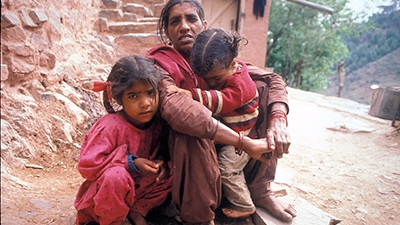Malnutrition is India’s silent emergency and among India’s greatest human development challenges. Although India has seen strong economic growth over the past 20 years, malnutrition in children under five years of age continues to be among the highest in the world.
Rates of malnutrition among India’s children are almost five times more than in China, and twice those in Sub-Saharan Africa. Nearly half of all India’s children - approximately 60 million - are underweight, about 45% are stunted (too short for their age), 20% are wasted (too thin for their height, indicating acute malnutrition), 75% are anemic, and 57% are Vitamin A deficient.
Malnutrition affects children’s chances of survival, increases their susceptibility to illness, reduces their ability to learn, increases their chances of dropping out early from school, and makes them less productive in later life. Much of this undernourishment happens during pregnancy and in the first two years of a child’s life and, without appropriate interventions, the damage to brain development and future economic productivity is largely irreversible.
Given its impact on health, education and economic productivity, persistent under-nutrition is a major obstacle to human development, impacting India’s much-awaited demographic dividend and the country’s prospects for future economic growth.
While aggregate levels of malnutrition in India are alarmingly high, there are significant inequalities across states and socioeconomic groups with girls, rural areas, the poorest people, and scheduled tribes and castes being the worst affected. Six states - Bihar, Chhattisgarh, Jharkhand, Madhya Pradesh, Rajasthan, and Uttar Pradesh - account for over half of India’s malnutrition cases, while an additional 8 to 10% of the burden is concentrated in specific areas of Andhra Pradesh and Maharashtra.
Inter-generational cycle of malnutrition
A number of factors are responsible for malnutrition. Inappropriate feeding and caring practices for young children, especially during the first two to three years of life are one of the major causes of malnutrition. This is often compounded by poor hygiene among dense populations that leads to the frequent occurrence of infections in young children, depleting their young bodies of nutrients.
Too often, new mothers are adolescents. A staggering 75% of them are anemic and most on put on less weight during pregnancy than they should - 5 kilograms on average compared to the worldwide average of close to 10kgs. Malnourished adolescent girls cannot deliver healthy babies, thereby perpetuating the inter-generational cycle of under-nutrition.
On the other hand, literate and more empowered mothers have better nourished children. Recent analyses in Bangladesh reaffirm evidence that when women are involved in household decisions and have control over earnings, their children are better nourished. It was also found that a woman’s experience of abuse and acceptance of domestic violence had a significant negative impact on her nutritional status, affecting her ability to produce a healthy baby.
In order to attain a fully healthy, well-nourished, and productive population, it is important to improve access to nutritious and diverse foods, clean water, sanitary environments, pre-natal services, and knowledge and support for appropriate child-feeding practices, such as exclusive breast-feeding for the first six months.
Integrated Child Development Services (ICDS) program - its restructuring and strengthening
Building on the premise that the lack of access to food is the primary cause of malnutrition in young children, India’s efforts to tackle the challenge have, in the past, focused primarily on distributing supplementary foods under the longstanding Integrated Child Development Services (ICDS) program.
While ICDS services have expanded rapidly nationwide, they have largely targeted children between 3-6 years of age, by which time malnutrition has already set in.
The Government of India has recently restructured the ICDS program with the aim of moving towards a more balanced multi-sectoral program to tackle this persistent challenge. The revised program will now focus on providing supplementary foods to pregnant women, nursing mothers and children under three years of age. It will also work to improve mothers’ feeding and caring practices as well as promote the immunization and growth monitoring of children. In addition, it will seek to provide pre-school education to children, thus encompassing the troika of food, health and child care which are the cornerstones for improving nutritional outcomes.
World Bank Support
The World Bank’s $106 million Integrated Child Development Services Systems Strengthening and Nutrition Improvement Program (ISSNIP) project is a first phase of a multi-phased program that will play a catalytic role in supporting the restructured ICDS, particularly in the poorer states where capacity is low and under-nutrition is high.
The project will support the government’s efforts to promote healthy pregnancy, timely and exclusive breastfeeding, infant and young child feeding practices, as well as improvements in personal hygiene with a particular focus on children under three. Additionally, the project will facilitate community mobilization and involvement as well as testing of innovative approaches and pilots in support of these efforts.
The project will finance innovative pilots in 162 high malnutrition-burden districts across eight states - Andhra Pradesh, Bihar, Chhattisgarh, Jharkhand, Madhya Pradesh, Maharashtra, Rajasthan and Uttar Pradesh. It will also help build institutional capacity and improve the synergies between the various national agencies involved in child nutrition and development.

